STASH, Vol. 21(12) – Wearable technology for detecting stress and cravings in substance use recovery
Cravings—the intense desire to use a substance or engage in a behavior—and stress play an important role in addiction recovery. Assessing cravings and stress has traditionally depended on self-report measures. However, the development of wearable digital technologies now make it possible to detect biomarkers of stress or cravings and respond in real time. Although these technologies show promise, it is important to determine how people in recovery experience and use these tools. This week, as part of our Special Series on Addiction and Technology, STASH reviews a study by Jazmin Hampton and colleagues that explored how people in substance use recovery and their treatment providers perceive a wearable digital system designed to detect stress and cravings.
What was the research question?
How do patients in substance use recovery and their treatment providers interact with and experience a wearable digital system that detects stress and cravings?
What did the researchers do?
The researchers recruited a sample of 31 patients (71.0% male and 93.5% White) and 11 treatment providers (63.6% female) from two private outpatient substance use treatment facilities. The patients were asked to wear the RAE Health digital detection system for 30 days. This wearable system identifies whether the patient is under stress or experiencing cravings based on their biomarkers. If detected, the system notifies the user of the stress and/or cravings and provides the option to engage in de-escalation practices immediately after. Treatment providers received training and information on the utility of the system during the trial period. After 30 days, the patients and their providers completed semi-structured interviews about their experiences with the system. The researchers used thematic analysis to identify themes pertaining to participants perceptions of and experiences with the digital detection system.
What did they find?
The researchers identified four primary themes (see Figure). In terms of experiences with stress and craving, participants experienced these both mentally and physically, and at different times and in different contexts. Overall, patients and providers had favorable perceptions of the digital detection system, such as that it helped identify when they may need additional recovery support. Participants identified barriers and facilitators to adopting the digital detection system. Barriers included general difficulties in maintaining an additional device (i.e., remembering to charge/wear the device) while facilitators were the relatively straightforward usability and nondescript nature of the system. Finally, participants spoke to desired features for the digital detection system, including improved integration with current technology like smartwatches. Many cited the push notifications as important reminders of recovery though some noted that the frequency and timing of these notifications could use improvement.

Figure. Displays the four themes pertaining to participants perceptions of and experiences with the digital detection system. Click to enlarge.
Why do these findings matter?
These findings support the utility of wearable digital tools that detect cravings and stress in substance use treatment, from the perspectives of people in recovery and their providers. More specifically, the finding that frequent notifications (when not overused) are useful reminders of recovery efforts suggests that this strategy may be effective, even in the absence of a wearable device. These findings also provide insight into potential improvements to these wearable technologies. For example, several participants noted the difficulty in managing an additional device and suggested that digital detection could be built into pre-existing tools like smartwatches.
Every study has limitations. What are the limitations in this study?
This study utilized a relatively small sample size which limits the generalizability of its findings. For example, 80.6% of participants were in treatment for alcohol use disorder. It is unclear whether experiences with the digital detection system vary for other objects of addiction (e.g., gambling). Furthermore, the study only tracked participants for 30 days and did not examine recovery outcomes, therefore we are unable to determine whether the tool was effective in supporting long term sobriety.
For more information:
Individuals who think they may be experiencing addiction should visit the CDC webpage for addiction information and resources. Others who want to learn more about recovery from addiction may benefit from visiting the National Institute of Drug Abuses webpage on treatment and recovery. Additional resources can be found at The BASIS Addiction Resources page.
—John Slabczynski
Want CE credit for reading BASIS articles? Click here to visit our Courses Website and access our free online courses.